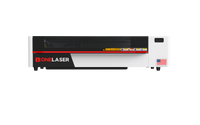Laser cutting fabric is a fast, accurate, and non-contact method for processing textiles in fashion, industrial, and creative applications. Whether you need sealed edges, intricate patterns, or custom engravings, a properly configured fabric laser cutting workflow eliminates fraying, reduces material waste, and enhances design complexity. This guide explains the essential principles, material compatibility, and optimized settings behind laser cutting fabric and laser engraving fabric with precision and consistency.

1. Benefits of Laser Cutting Fabric Compared to Traditional Methods
Unlike scissors, rotary blades, or die cutters, laser technology offers unmatched precision, repeatability, and design flexibility. Its contactless nature preserves material integrity while speeding up production.
Key Advantages of Fabric Laser Cutting:
- No fraying or unraveling: Laser-sealed edges prevent textile degradation.
- Contactless operation: No mechanical pressure or distortion on soft or stretchy fabrics.
- High design freedom: Cut lacework, geometric patterns, text, or logos with ease.
- Automated repeatability: Perfect for mass production of appliqué, stencils, or templates.
- Material savings: Ultra-narrow kerf reduces waste and improves yield per sheet.
2. What Type of Laser Can Engrave and Cut Fabric?
For fabric processing, not all laser machines are created equal. Systems like the OneLaser X Series and Hydra Series are engineered to deliver precise, high-speed performance on textile materials. These CO₂-based platforms combine stable motion control, efficient airflow systems, and optimized beam delivery—making them ideal for everything from detailed engraving on canvas to cutting through dense polyester or felt. Whether you're prototyping apparel or producing custom textile goods at scale, these machines offer the beam quality and power control needed for consistent results.
2.1 Best Laser Types for Fabric Processing:
- CO₂ Lasers (10.6 μm wavelength):
The gold standard for fabric laser cutting. CO₂ lasers are highly absorbed by both natural fibers (cotton, wool) and synthetics (polyester, nylon), providing:- Sealed edges with minimal fray
- Smooth engraving on canvas, fleece, and denim
- Compatibility with a wide range of textiles
- Fiber Lasers (1.06 μm wavelength):
Not recommended for fabric. Their wavelength is optimized for metals, not textiles. Using one on fabric may burn through unpredictably or leave no mark at all. - Diode Lasers (low power, 5–10 W):
Can lightly engrave on light-colored cotton or synthetics but lack cutting power. Suitable only for hobby-level engraving, not professional cutting.
Ideal Choice:
A CO₂ laser fabric cutting machine, especially one equipped with an RF tube—as found in advanced models like the Hydra Series—offers clean edge control, fine raster capability, and production-grade reliability for both laser cutting fabric and laser engraving fabric with minimal distortion or setup complexity.
2.2 Best Laser Engraver for Fabric
Choosing the right laser engraver for fabric involves more than just power—it's about precision, airflow, and motion stability. For high-quality textile work, especially when working with variable weaves, thicknesses, and fiber types, your machine needs to deliver consistent beam focus and effective fume extraction without distorting the fabric.
Recommended Systems for Fabric Laser Engraving and Cutting:
a. OneLaser X Series
Compact and reliable, the OneLaser X Series is built for precision textile processing in small to mid-sized production environments. It features:
- A stable CO₂ glass laser tube with balanced power output
- Closed-loop motion control for smooth raster engraving
- Optional air assist and exhaust systems for clean, sealed edges
- Ideal for patch production, small apparel jobs, and prototyping

b. OneLaser Hydra Series
Engineered for industrial-grade performance, the Hydra Series excels in speed, repeatability, and resolution. It is particularly suited for high-throughput textile applications such as upholstery, fashion accessories, and technical fabrics. Key features include:
- Dual-laser setup (RF and DC tube support) for switching between deep cutting and fine engraving
- Autofocus and Z-axis adjustment to handle uneven materials or layered textiles
- Knife-blade bed and vacuum assist for safe fabric positioning
- Fast engraving at up to 1000 mm/s with minimal vibration

c. Why OneLaser Works Well on Fabric:
High-speed rastering enables efficient processing of logos, patterns, or full-surface texture effects.
Fine beam control ensures clean, narrow cuts—even on delicate materials like silk or chiffon.
Consistent airflow and fume extraction minimize smoke buildup and fabric scorching.
Whether you're creating custom denim graphics, fashion cutouts, or engraved felt components, the OneLaser X Series and Hydra Series are both powerful and dependable choices for professional fabric engraving and cutting workflows.
3. Applications and Industries Using Fabric Laser Cutting
Laser cutting and engraving fabric is common in industries that demand fast prototyping, high customization, and edge consistency.
Common Industries and Projects:
- Apparel and Fashion: Appliqué, lace, engraved patterns, or layered garment components.
- Interior Design: Draperies, lampshades, acoustic panels, wall textiles.
- Technical Textiles: Filter membranes, protective wear, automotive interiors.
- Craft and DIY: Personalized gifts, textile art, cosplay, quilting.
- Industrial Sealing: Cut neoprene or fabric-based gaskets and thermal wraps.
4. Best Fabrics for Laser Cutting and Engraving
Not all fabrics are laser-safe. Material composition, weave type, and finish can all impact the cutting and engraving result.
Laser-Compatible Fabrics:
- Cotton, Linen: Crisp engraving and moderate charring on edges.
- Polyester, Nylon: Melts cleanly for smooth edges; suitable for cutting and shallow engraving.
- Felt, Fleece: Textures well with laser; great for craft and patchwork.
- Denim, Canvas: Engraves well with good color contrast.
- Silk, Chiffon: Can be laser-cut if processed with high speed and low power to prevent warping.
Fabrics to Avoid:
- PVC-Coated or Vinyl Fabrics: Release toxic chlorine gas when cut.
- Highly Elastic Fabrics: Can distort or stretch under beam heat.
- Unknown Fiber Blends: Always review the MSDS to confirm laser safety.
5. Laser Cutting Fabric
Proper configuration is key to achieving clean, sealed edges and detailed cuts when working with fabric. Laser cutting differs from traditional methods by using focused thermal energy rather than pressure or abrasion. However, fabrics are more heat-sensitive than rigid materials—so power, speed, and airflow must be carefully tuned to avoid scorching, melting, or shifting.
Recommended Settings:
- Power: 10–40%
Lower power settings are ideal for thinner or synthetic fabrics, while natural fibers like cotton or denim may require closer to 30–40%. Always start low and increase gradually to find the threshold that cleanly cuts without burning. - Speed: 300–800 mm/s
Higher speeds reduce heat dwell time and minimize edge charring. Lighter fabrics such as silk or polyester benefit from faster speeds, while denser materials like felt or canvas may require slightly slower passes. - Frequency: 15–25 kHz (RF CO₂ systems)
For users operating RF-powered CO₂ lasers, higher frequency allows smoother edge transitions on fabric. Around 20 kHz is often a safe middle ground for textiles. - Air Assist: Off or minimal
Excessive airflow can lift or wrinkle lightweight fabrics during processing. Use low-flow or diffused air if necessary to keep debris away from the beam path without disturbing the material. - Table Type: Honeycomb or pin table with vacuum hold-down
Maintaining flatness is crucial for beam focus and edge consistency. Vacuum tables or honeycomb beds with weights/tape are effective in preventing fabric lift or distortion during cutting.
Tips for Success:
- Run test cuts first
Every fabric behaves differently under a laser. Always perform a test cut using a small section of the material to dial in your power and speed settings before committing to full-scale production. - Secure your fabric
Fabrics can shift easily with even slight motion. Use fabric weights, magnets, or heat-safe masking tape to secure the material at the corners and edges without affecting the cut area. - Defocus slightly for synthetics
For sensitive materials like satin, chiffon, or polyester, intentionally defocusing the laser head by 0.3–0.5 mm spreads the beam energy and reduces heat concentration, preventing shrinkage or melted edges. - Keep optics clean
Fabrics release fine particles and smoke when burned. Dirty lenses and mirrors reduce beam quality and can cause inconsistent results. Clean optics regularly using lens-safe wipes and approved solvents.
By following these optimized settings and practical tips, fabric laser cutting becomes a consistent, scalable solution for both creative and commercial applications.
6. Laser Engraving Fabric
Laser engraving on fabric is a non-contact method of marking that uses surface-level ablation to create custom patterns, brand marks, textures, or even image engravings without penetrating all the way through the textile. By carefully tuning laser power and speed, users can achieve anything from subtle discoloration to bold contrast on a wide range of fabrics.
Popular Use Cases:
- Tote Bags and Denim Patches:
Branding canvas bags, denim jackets, or patch blanks with logos or monograms is a popular commercial application. Engraving maintains the textile's structure while adding permanent, professional-quality marks. - Texture Effects on Soft Fabrics:
Materials like fleece, felt, or suede engrave with a "burned" nap effect, creating embossed-looking patterns without physically altering the fabric thickness. Ideal for layering textures in fashion or craft projects. - Guides for Quilting or Sewing:
Lasers can mark light outlines or stitch patterns on cotton and other quilting materials, replacing hand-drawn or transferred guides with high precision, repeatability, and speed. - Leather and Faux Leather Branding:
Engraving on leather substitutes or genuine leather produces clean tonal effects, ideal for logos, serial codes, or decorative elements on wallets, keychains, and tags. The laser lightly chars the surface to enhance contrast without cutting through.
Engraving Tips by Fabric:
- Cotton and Denim:
Use moderate power and slower speeds to generate deeper engraving tones with high contrast. These natural fabrics char slightly under the beam, which creates a darkened, readable mark that won't wash out. - Fleece and Felt:
Reduce power and increase speed to prevent the fibers from becoming crusty or burned. Light rastering can still provide visible texture changes without compromising the soft surface feel. - Polyester Blends:
Because synthetics can melt or deform under heat, use fast scan speeds, low power, and grayscale designs. Raster-fill patterns are preferable to high-power vector strokes, which may overheat small areas.
Additional Tips:
- Use 300–600 DPI for Raster Artwork:
For most fabric engraving, this range provides enough resolution for detail without oversaturating the fabric with heat. - Always Test on Scrap First:
Even fabrics with similar names or blends can react differently. Testing ensures the engraving doesn't damage or overly darken the material. - Watch for Puckering:
Particularly with thin or stretchy materials, keep an eye on surface tension. Reducing power or using tape to flatten the surface can prevent warping.
With proper settings and testing, laser engraving fabric allows for stunning, high-impact visuals with excellent durability—and without the need for inks, transfers, or stitching.
FAQs
Q1: Can all fabrics be laser cut?
No. Only laser-safe fabrics—like cotton, polyester, felt, and denim—should be used. Avoid PVC-coated materials or unknown fiber blends.
Q2: Do laser-cut fabric edges fray?
No. One of the main benefits of fabric laser cutting is that the edges are sealed by the laser, preventing fraying or unraveling over time.
Q3: Can I engrave patterns onto stretch fabrics?
Engraving stretch fabrics is difficult. Heat may distort them unless tensioned properly. Use test pieces and reduce power to avoid damage.
Q4: What laser power is ideal for fabric engraving?
A 40–80W CO₂ laser is generally sufficient. For engraving only, even a 30W machine can perform well on light materials.
Q5: Does laser engraving wash off fabric?
No. Laser engraving is a permanent surface effect—by burning or melting the surface fibers. However, its visibility depends on fabric color and type.
Conclusion
Laser cutting fabric and laser engraving fabric provide unmatched flexibility, precision, and finish quality for textile applications. Whether you're working with soft cotton or industrial polyester, a laser fabric cutting machine delivers sealed edges, rapid prototyping, and intricate detailing without contact wear or fraying. With the right material, settings, and design preparation, you can streamline production while expanding creative potential across fashion, interior design, or technical textile applications.
Let us know if you'd like a downloadable fabric laser settings chart or a template for raster engraving designs.

 Liquid error (sections/image-banner line 171): invalid url input
Liquid error (sections/image-banner line 171): invalid url input





